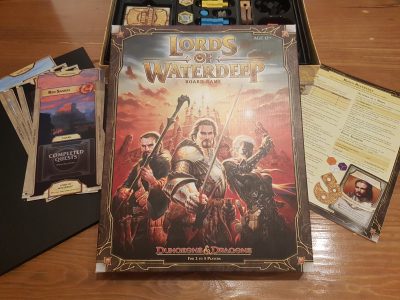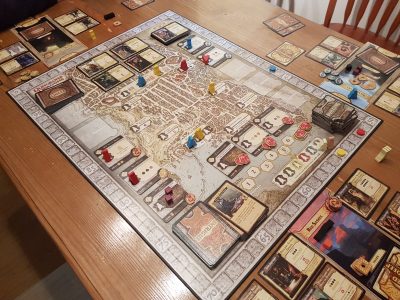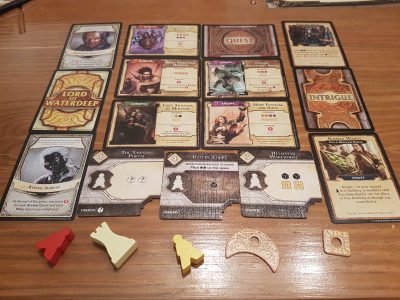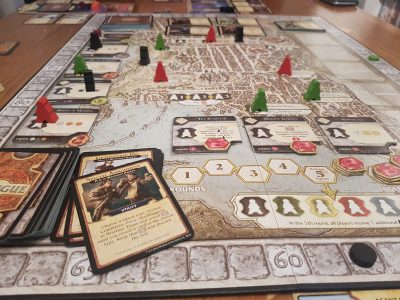Lords of Waterdeep is a fantasy themed worker placement game where 2 – 5 players take up the roles of masked lords. Each of these lords must recruit agents, deploy workers and complete quests in an attempt to rack up points. As the name suggests this all takes place in the Forgotten Realm’s city of Waterdeep, part of the Dungeons & Dragons universe. Fortunes will be made, intriguing events will occur yet does Lords of Waterdeep, released back in 2012, still hold gamers’ attentions? Let’s find out!
On a turn in Lords of Waterdeep a player takes one of their available worker meeples, places it onto a space on the board and performs the action awarded by the space. Once an action space has claimed by a player it is then unavailable for the rest of the game, so being flexible is somewhat key. After placing a meeple onto the board play moves to the next player and so on. After all workers from all players are placed the round ends, meeples are returned to their respective owner and a new round starts. The game lasts for 8 rounds, approximately lasting 45 minutes – 1 hour, and at the ends whomever has amassed the most victory points wins.
Simply placing workers won’t get players victory points, instead they’ll aid the player to get some in the form of resources or quests to complete. Resources in Lords of Waterdeep come in 5 forms: Gold, white Clerics, orange Fighters, black Rogues and purple Wizards. These will score points at the end of the game if unused. To gain more points from them it is worth utilizing resources to complete quest cards, that can be obtained throughout the game by visiting the Cliffwatch Inn spaces.
Whether completing a claimed quest, or one of the two players are death at the beginning of the game, there are attributes to pay attention to. Cost, which denotes the amounts and types of resources needed to complete it, is clearly indicated. Potentially, the most important bit is the standard reward earnt for completing it: that can range from just victory points to also gaining resources. Quests fall into 4 categories: Arcane, Skulduggery, Piety and Warfare. The quest type is stated clearly at the top left of the card, evening using colour to distinguish each at a glance.
This is important as at the offset of the game each player is dealt a face down lord card. Each lord gives a bonus of 4 points at the end of the game for each completed quest of two types. This can make it worth spamming several small, low point scoring, quests during the game to rake in the bonus points. As lords are dealt randomly this can see a game where everyone is aiming for an even spread of quest types or cause conflict as one type becomes beneficial for all players to complete.
Some quests are denoted as “plot quests” that have on-going effects. These can see additional resources or gold produced for specific actions, score additional points for constructing buildings or even letting you control the Lieutenant (a bonus worker) for the rest of the game. To balance these plot quests they often have a higher cost, slightly mitigating the luck aspect of these becoming available randomly from the draw deck.
Aside from completing quests the games Intrigue cards are also source, albeit lesser source, of victory points. There are three action spaces at Waterdeep Harbour which allow Intrigue cards to be played. These cards are always good to some extent but range from being solely beneficial to the card player, benefiting everyone or being detrimental to an opponent. An example of these cards is “Recruit Spies”, which sees the player earn 2 rogues from the bank and then each opponent can give the player a rogue for 3 victory points. Not only is this good for the player using the card, opponents can also benefit victory point wise so timing is key.
Once an intrigue card has been played that meeple has been used for the turn, though not the round. At the end of the round any workers at Waterdeep Harbour can be redeployed, in order that they were placed there. Choice is significantly limited so it isn’t always the best action to take, making it feel more like 1.5 actions rather than getting a second full action for free. This is an extremely interesting mechanic that opens up a strategy of gaining and utilizing Intrigue each turn. While I’ve not been successful with it, others have beaten me via this technique.
Despite representing a whole city, the board is tight and constricted if buildings aren’t built early on. This is especially the case after round 5 when everyone gets another worker added to their available pool. The Builder’s Hall action space enables players to purchase buildings that open up new actions for all players. These often feature a better return resource-wise for spending workers on. So where is the advantage of making a better action space available to everyone? There is an instant benefit, in the form of victory points, and owner bonuses to watch out for.
At the start of each round a victory point token is added to the three building tiles that are available to be built from the Builder’s Hall. These build up overtime making unclaimed buildings worth more victory points. This can be a great way, especially late in the game, to turn gold (2 gold = 1 victory point) into more points. When a player builds something, they place it onto the board as an available action space and put a control marker onto it. Whenever another player uses their building they get an owner bonus. Bonuses can range from straight victory points to resources, getting the owner things even when it isn’t their turn. There is a decision to be made if a building’s action would really help another player but mostly the owner bonuses make it worthwhile.
One feature which has cropped up in many subsequent worker placement games is the way Lords of Waterdeep treats turn order. It can be claimed, at least who starts the turn order, so isn’t quite to the level of more recent worker placement games, such as Viticulture. Instead of trading away turn order for a benefit there is a space, Castle Waterdeep, that claims the first player marker. This is certainly a benefit enabling that player complete choice over what action space to take. Alas, especially in a 5-player game, it is harsh when someone ends up going last, gaining no benefit after the start of the game gold bonus, due to the player to their left wanting to go first.
Lords of Waterdeep is a bit of a cutthroat worker placement with limited opportunities to get what you need each round. This is compounded by most action spaces only allowing a single worker meeple to be placed. While there are ways of negating this, via specific plot quests or building actions, for the most part an action can be used only once per round. This wouldn’t be an issue if each resource type could be earnt in different ways. The cutthroat side is added in due to each resource only having one action that generates them, making going first that bit more valuable. Buildings can alter this but players are left praying spaces won’t be claimed before it’s their turn either way.
One complaint I have with the components is the use of coloured cubes for resources. Cubes are generic and a bit bland while they are supposedly representing Fighters, Clerics, Wizards and Rogues. It keeps things simplified and the iconography on cards to a minimum, but they don’t work thematically. There isn’t the strong link between what the cubes represent and the quests you send them on. Before long, if gamers even bother to learn what colour is what recruit type, players will just be talking in cubes. It also feels wrong to just place piles of cubes on the board. Including small dishes to bring them out of the box and into the centre of the board would just help keep the game a bit neater.
Setting the annoyances of cubes aside the production value of Lords of Waterdeep still shines strong, despite several games released at the same time, or since, faltering at today’s standards. The art that adorns the cards is all contextual and relevant to the quest or Intrigue. A few of the cards do re-use the same artwork but the decks are big enough not to worry about this. The amount also helps the game stay fresh, even after a few games new unseen cards were still appearing. The gold tokens are also worthy of praise. Made of a decently thick cardboard, they don’t reach the heights of metal coins. In spite of this, the crescent moon shape used for the 5 gold tokens and the centralised hole in them make them feel different to the touch. This just elevates the game that little bit by making the components above standard and acceptable.
Several different, and importantly effective, strategies are open to players. Controlling one of the resource types can drastically cause opponents plans to unravel. On top of this resources of any kind earn victory points, so why not horde? Should players aim to complete every quest they have, aim to only complete the high point scoring ones or plenty of small point scorers? You can even ignore influence cards altogether or look to spam them down each round to affect the game in differing ways. Each strategy has seemingly paid off at one time or another, so which is best I still haven’t worked out: and this drives me to play more!
For those new to the hobby don’t be put off by gamers saying you need the expansion for Lords of Waterdeep to be enjoyable. This is a mechanically solid worker placement game that has already provided hours of entertainment in its base form. While it may benefit from the expansion, it is far from necessary for the game to shine. There are excellently used mechanics drawing the experience together into a tight, balanced game. If you’re up for a slightly more confrontational worker placement this will be perfect for you. For me Lords of Waterdeep doesn’t grab the crown from Viticulture Essential Edition but it will be my go to gateway game for the genre!
[Editor’s Note: Lords of Waterdeep was provided to us by Esdevium Games for review purposes. The game is currently available on 365 Games for £29.39. It is also available from local UK board game stores, find your local store here]





